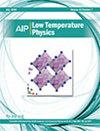Propyne confinement in solid parahydrogen: Methyl rotation and site effects
IF 0.8
4区 物理与天体物理
Q4 PHYSICS, APPLIED
引用次数: 0
Abstract
Samples of propyne trapped in solid parahydrogen show multiple peak structures in their infrared spectra. These structures are attributed to molecules in two distinct kinds of matrix sites. The most intense lines are assigned to propyne molecules executing a slightly hindered methyl rotation, as was extensively studied in our earlier publication from our two groups, and the other set of peaks to propyne trapped in a secondary site where the methyl rotation is quenched and replaced by methyl torsion within the matrix site. The assignment of the various rovibrational transitions is made possible by the observation of nuclear spin conversion (NSC) within the methyl group at long timescales. The NSC rate depends on the site and is much slower in the sites where the methyl rotation is quenched.固态对氢中的丙炔约束:甲基旋转和位点效应
被困在固体对氢中的丙炔样品在其红外光谱中显示出多个峰值结构。这些结构可归因于处于两种不同基质位点的分子。最强烈的谱线归因于执行略微受阻的甲基旋转的丙炔分子,这在我们两个小组早先发表的文章中进行了广泛的研究;另一组峰值归因于被困在次级位点中的丙炔,在该位点中,甲基旋转被淬灭,取而代之的是基质位点内的甲基扭转。通过观察甲基内长时间尺度的核自旋转换(NSC),可以确定各种振荡跃迁。核自旋转换率取决于位点,在甲基旋转被淬灭的位点,核自旋转换率要慢得多。
本文章由计算机程序翻译,如有差异,请以英文原文为准。
求助全文
约1分钟内获得全文
求助全文
来源期刊

Low Temperature Physics
物理-物理:应用
CiteScore
1.20
自引率
25.00%
发文量
138
审稿时长
3 months
期刊介绍:
Guided by an international editorial board, Low Temperature Physics (LTP) communicates the results of important experimental and theoretical studies conducted at low temperatures. LTP offers key work in such areas as superconductivity, magnetism, lattice dynamics, quantum liquids and crystals, cryocrystals, low-dimensional and disordered systems, electronic properties of normal metals and alloys, and critical phenomena. The journal publishes original articles on new experimental and theoretical results as well as review articles, brief communications, memoirs, and biographies.
Low Temperature Physics, a translation of the copyrighted Journal FIZIKA NIZKIKH TEMPERATUR, is a monthly journal containing English reports of current research in the field of the low temperature physics. The translation began with the 1975 issues. One volume is published annually beginning with the January issues.
 求助内容:
求助内容: 应助结果提醒方式:
应助结果提醒方式:


